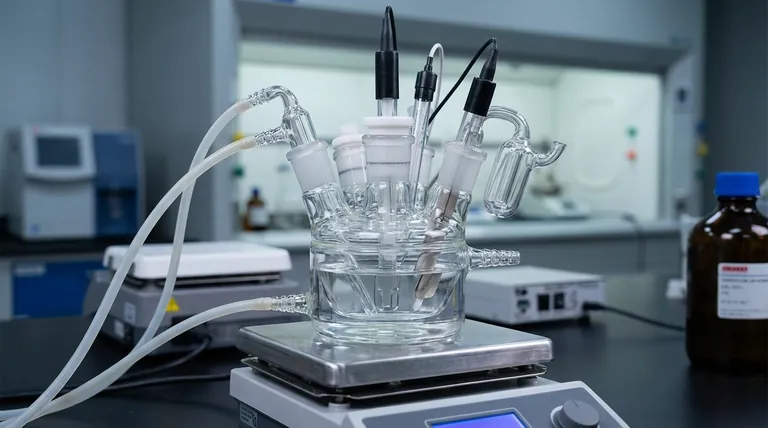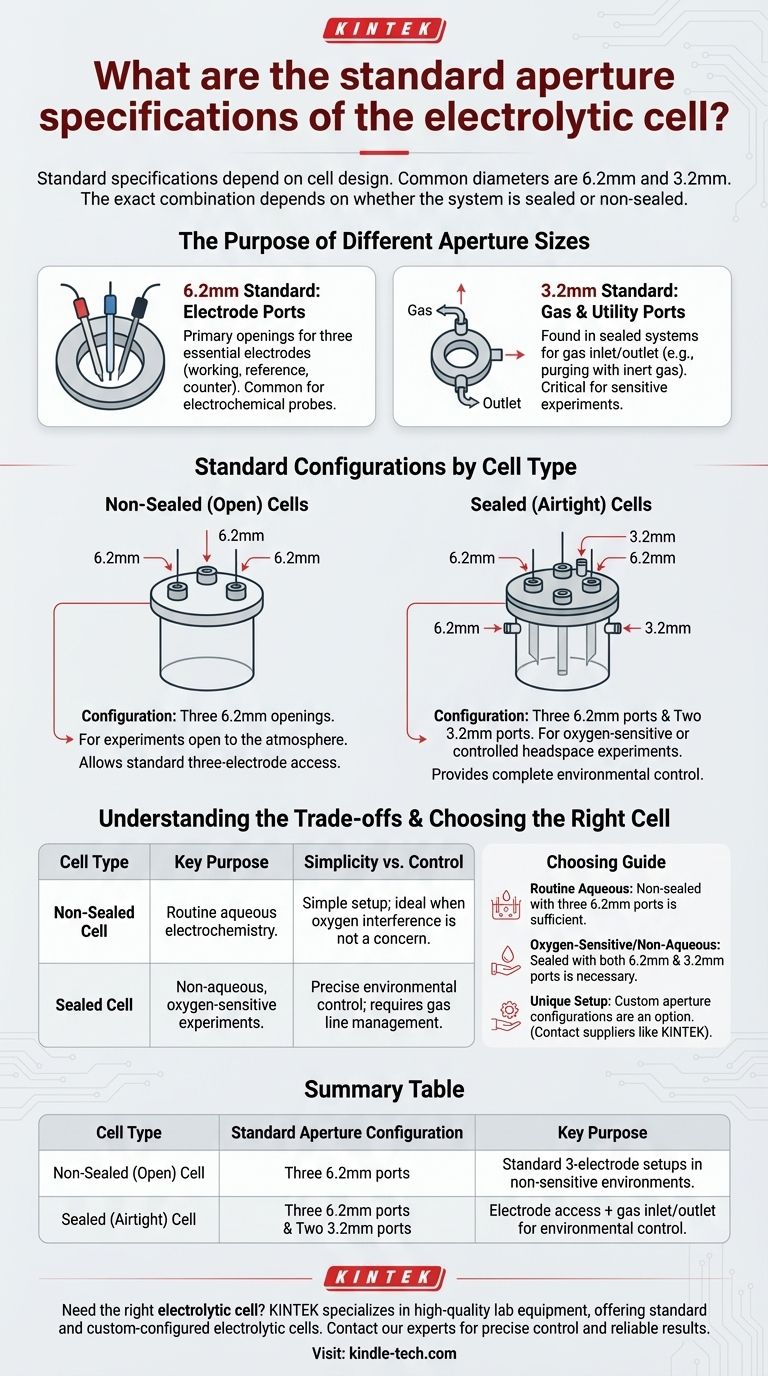The standard aperture specifications for an electrolytic cell depend directly on its design, but the most common diameters you will encounter are 6.2mm and 3.2mm. The exact number and combination of these ports are determined by whether the cell is a sealed or non-sealed system.
The critical distinction is not a single universal standard, but rather two common configurations based on function. Non-sealed cells typically feature three 6.2mm ports for electrodes, while sealed cells add two 3.2mm ports for gas control.

The Purpose of Different Aperture Sizes
The two standard diameters are not arbitrary; they are designed to accommodate specific components required for electrochemical experiments. Understanding their intended use is key to selecting the right equipment.
The 6.2mm Standard: Electrode Ports
The larger 6.2mm diameter ports are the primary openings in the cell.
Their main purpose is to house the three essential electrodes: the working electrode, the reference electrode, and the counter (or auxiliary) electrode. This size is a common standard for commercially available electrochemical probes.
The 3.2mm Standard: Gas and Utility Ports
The smaller 3.2mm diameter ports are found on sealed cell systems.
These are utility ports, typically used for gas inlet and outlet tubes. This allows for purging the electrolyte with an inert gas like nitrogen or argon to remove dissolved oxygen, which is critical for many sensitive experiments.
Standard Configurations by Cell Type
The most significant factor determining the aperture layout is whether the cell needs to be environmentally isolated.
Non-Sealed (Open) Cells
For experiments that can be performed open to the atmosphere, a non-sealed cell is sufficient.
The standard configuration for this type is simple: three 6.2mm openings. This setup provides the necessary access for a standard three-electrode system without the complexity of atmospheric control.
Sealed (Airtight) Cells
For experiments sensitive to air, moisture, or those requiring a controlled headspace, a sealed cell is necessary.
The standard configuration for a sealed cell is three 6.2mm openings for the electrodes and two 3.2mm openings for gas lines. This five-port design provides a complete, controlled electrochemical environment.
Understanding the Trade-offs
Choosing a cell configuration involves balancing experimental requirements with operational simplicity.
Simplicity vs. Control
A non-sealed cell is simpler to set up and use, making it ideal for many routine analyses, particularly in aqueous solutions where oxygen interference is not a primary concern.
A sealed cell provides precise environmental control, which is non-negotiable for non-aqueous electrochemistry, studies of oxygen-sensitive redox couples, or experiments involving volatile substances. This control comes with the added complexity of managing gas lines and ensuring a proper seal.
The Option of Customization
It is important to recognize that these are standard configurations. Most equipment suppliers offer custom drilling or alternative lid configurations upon request. If your experiment requires a unique probe, sensor, or sampling port, custom specifications are almost always an option.
Choosing the Right Cell Configuration
Your experimental goal is the ultimate guide to selecting the correct aperture setup.
- If your primary focus is routine aqueous electrochemistry: A non-sealed cell with three 6.2mm ports is typically sufficient and the most straightforward choice.
- If your primary focus is oxygen-sensitive or non-aqueous experiments: You will require a sealed cell with both 6.2mm electrode ports and 3.2mm gas ports for environmental control.
- If your primary focus is a unique experimental setup: Inquire about custom aperture configurations to precisely match your specific electrode and probe dimensions.
Understanding these standard configurations allows you to select the appropriate electrolytic cell that provides the necessary control for your specific experimental goals.
Summary Table:
| Cell Type | Standard Aperture Configuration | Key Purpose |
|---|---|---|
| Non-Sealed (Open) Cell | Three 6.2mm ports | For standard three-electrode setups in non-sensitive environments. |
| Sealed (Airtight) Cell | Three 6.2mm ports & Two 3.2mm ports | For electrode access plus gas inlet/outlet for environmental control. |
Need the right electrolytic cell for your specific experiment? KINTEK specializes in high-quality lab equipment and consumables, offering both standard and custom-configured electrolytic cells to ensure precise control and reliable results for your electrochemical research. Contact our experts today to discuss your requirements and find the perfect solution for your laboratory needs.
Visual Guide

Related Products
- Double Layer Five-Port Water Bath Electrolytic Electrochemical Cell
- Double-Layer Water Bath Electrolytic Electrochemical Cell
- Quartz Electrolytic Electrochemical Cell for Electrochemical Experiments
- H-Type Double-Layer Optical Electrolytic Electrochemical Cell with Water Bath
- H Type Electrolytic Cell Triple Electrochemical Cell
People Also Ask
- What precautions should be taken regarding temperature control for the electrolytic cell? Ensure Safe & Accurate Electrolysis
- How should the electrolytic cell be secured on the stand during an experiment? A Step-by-Step Guide for Stability
- When is chemical cleaning necessary for an electrolytic cell, and how should it be performed? A Guide to Removing Stubborn Deposits
- What regular inspection and maintenance activities are required for the electrolytic cell? Ensure Reliable Results & Extend Equipment Life
- What inspection steps should be performed before using the electrolytic cell? A Guide to Safe & Accurate Experiments



















